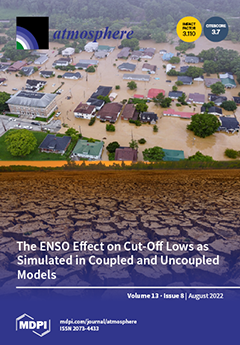Ozone (O
3) is an important secondary substance that plays a significant role in atmospheric chemistry and climate change. Although O
3 is essential in the stratosphere, it is harmful to human health in the troposphere, where this study was conducted. In recent years, O
3 pollution in the Beijing-Tianjin-Hebei (BTH), Yangtze River Delta (YRD), and Pearl River Delta (PRD) regions has deteriorated, which has become an important environmental problem. The generation of O
3 is closely related to meteorological factors. In this study, the weather classification method was adopted to study the effect of meteorological conditions on O
3 concentration. In the BTH region, Tianjin was selected as the representative city for the research. The real-time pollutants data, meteorological re-analysis data, and meteorological data in 2019 were combined for the analysis. The subjective weather classification method was adopted to investigate the effects of different weather types on O
3 concentration. The backward trajectory tracking model was used to explore the characteristics and changes of O
3 pollution under two extreme weather types. The results indicate there is a good correlation between O
3 concentration and ambient temperature. Under the control of low pressure on the ground and the influence of southwest airflow in the upper air for Tianjin, heavy O
3 pollution occurred frequently. The addition of external transport and local generation will cause high O
3 values when the weather system is weak. The O
3 concentration is closely related to ambient temperature. Continuous high-temperature weather is conducive to the photochemical reaction. The multi-day O
3 pollution process would occur when the weather system is robust. The first and second types of extreme weather are more likely to cause persistent O
3 pollution processes. Under the premise of stable emission sources, the change in weather patterns was the main reason affecting the O
3 concentration. This study aims to improve O
3 pollution control and air quality prediction in the BTH region and large cities in China.
Full article





